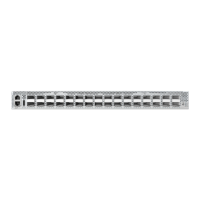C
HAPTER
45
| IP Routing Commands
Open Shortest Path First (OSPFv2)
– 1059 –
COMMAND USAGE
◆ All areas must be connected to a backbone area (0.0.0.0) to maintain
routing connectivity throughout the autonomous system. If it not
possible to physically connect an area to the backbone, you can use a
virtual link. A virtual link can provide a logical path to the backbone for
an isolated area, or can be configured as a backup connection that can
take over if the normal connection to the backbone fails.
◆ A virtual link can be configured between any two backbone routers that
have an interface to a common non-backbone area. The two routers
joined by a virtual link are treated as if they were connected by an
unnumbered point-to-point network.
◆ Any area disconnected from the backbone must include the transit area
ID and the router ID for a virtual link neighbor that is adjacent to the
backbone.
EXAMPLE
This example creates a virtual link using the defaults for all optional
parameters.
Console(config-router)#network 10.4.0.0 0.255.255.0.0 area 10.4.0.0
Console(config-router)#area 10.4.0.0 virtual-link 10.4.3.254
Console(config-router)#
This example creates a virtual link using MD5 authentication.
Console(config-router)#network 10.4.0.0 0.255.255.0.0 area 10.4.0.0
Console(config-router)#area 10.4.0.0 virtual-link 10.4.3.254 message-digest-
key 5 md5 ld83jdpq
Console(config-router)#
RELATED COMMANDS
show ip protocols ospf (1082)
network area This command defines an OSPF area and the interfaces that operate within
this area. Use the no form to disable OSPF for a specified interface.
SYNTAX
[no] network ip-address netmask area area-id
ip-address - Address of the interfaces to add to the area.
netmask - Network mask of the address range to add to the area.
area-id - Area to which the specified address or range is assigned.
An OSPF area identifies a group of routers that share common
routing information. The area ID can be in the form of an IPv4
address or as a four octet unsigned integer ranging from
0-4294967295.

